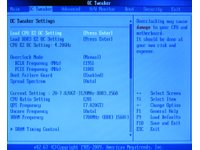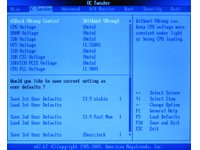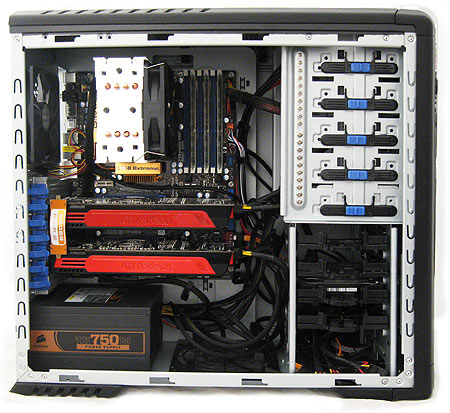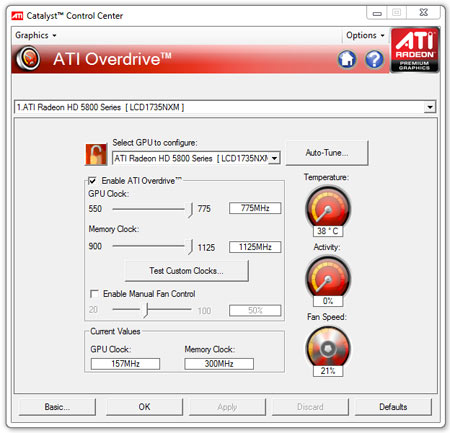System Builder Marathon, March 2010: $1,500 Enthusiast PC
Assembly And Overclocking
The best assemblies are the ones where I don't have a lot to talk about, which means that things have gone smoothly. This is one of those builds. The Cooler Master CM 690 case provides a lot of space and decent cable management, so there isn't much to talk about on that front. Even the large Radeon HD 5850 cards have a lot of breathing room. Indeed, all of the hardware and software installations went off without a hitch.
Overclocking
Overclocking this beast was simultaneously disappointing and impressive.
Let's start with the disappointing stuff: we had a heck of a time getting any stability past 3.7 GHz, even though the Rosewill Fort 120 cooler was doing an awesome job keeping the CPU temperatures down. While the system didn't have a problem booting over 4 GHz, running a Prime95 stress test would crash it fairly quickly. With load temps under 75 degrees Celsius, we were surprised that upping the voltage didn't help. If anything, it seemed to crash faster. Further testing confirmed that it was actually the extra voltage that caused the crashes.
After discovering the extra-voltage limitation, we got to the impressive part: with some more tweaking at stock voltage, this Core i7-920 CPU remained stable all the way up to 3.9 GHz. With the voltage this low, even a Prime95 load test resulted in CPU temperatures below 70 degrees Celsius (an extremely low result for an overclocked Core i7). Our target with a reasonable voltage increase was a stable 24/7 overclock in the 4.1 GHz neighborhood, so 3.9 GHz isn't a terrible trade-off, considering the low power usage and temperatures. A 1,233 MHz overclock at stock voltage speaks to the success of the Core i7-920 D0 stepping.


As far as the graphics cards are concerned, PowerColor's Radeon HD 5850 cards overclock to the maximum Overdrive limits in the Catalyst Control Center (CCC) without any extra effort. These cards could probably go further than the 775 MHz core and 1,125 MHz memory limitations built into their BIOS, but since we're running these in a CrossFire configuration and want to keep things as stable as possible.
Get Tom's Hardware's best news and in-depth reviews, straight to your inbox.
Current page: Assembly And Overclocking
Prev Page Memory, Hard Drive, And Optical Drive Next Page Test System And BenchmarksDon Woligroski was a former senior hardware editor for Tom's Hardware. He has covered a wide range of PC hardware topics, including CPUs, GPUs, system building, and emerging technologies.
-
skora I find it funny Cleeve that you mention the effects of ATIs monopoly on the high end GPU market but nothing on the CPU front. How much better off would we all be if AMD had a competing product for the Core i5/7s.Reply
Out of curiosity, how big is the storage capacity needed for your benchmark suit? I know you were over budget, but how close could you have come to one of the lower capacity SSDs and their performance advantages? -
The labels on all the charts appear to be wrong. They're mentioning a "Current $1300 System" but I thought the current system was $1500?Reply
-
anamaniac To be honest, this just somehow seems disappointing to me.Reply
But then I think of how much I spent on my rig, and got less, I'm even more disappointed.
It's crazy that prices keep raising on everything though. 6 months ago I was $9/GB for DDR2, in Canadian dollars. $12.50/GB for DDR3. It's absolutely ridiculous. -
Crashman OtusIt looks like i5->i7 is not worth it for gamers. The increases when FPSReply
I've got news for you: i3->i7 is not worth it for gamers. Tom's Hardware has an interesting article in the works. -
p1n3apqlexpr3ss @CrashmanReply
Sounds good, this something to do with the i3 HTed vs traditional quad thing? -
Crashman p1n3apqlexpr3ss@CrashmanSounds good, this something to do with the i3 HTed vs traditional quad thing?Reply
I think it's a Windows 7 thread shifting and dual-threaded games thing, since both the i3 and i7 have HT. -
Stardude82 SethVNThe labels on all the charts appear to be wrong. They're mentioning a "Current $1300 System" but I thought the current system was $1500?Reply
The whole comparison is BS. $200 is a lot of money where I come from and the stock cooling on the i5 750 is garbage. The low-end Conroes had much better cooling and they were only 65W TDP. I say stick your no-name heatsink on last quarters machine, call it a $1400 box, redo the overclocking and then publish the results as that way they will be at least somewhat relevant.


